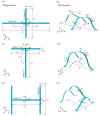Postbuckling analyses of frame mesostructures consisting of straight ribbons for mechanically guided three-dimensional assembly
- PMID: 31236053
- PMCID: PMC6545037
- DOI: 10.1098/rspa.2019.0012
Postbuckling analyses of frame mesostructures consisting of straight ribbons for mechanically guided three-dimensional assembly
Abstract
Mechanically guided assembly through buckling-induced two-dimensional (2D)-to- three-dimensional (3D) transformation represents a versatile approach to the formation of 3D mesostructures, thanks to the demonstrated applicability to a wide range of length scales (from tens of nanometres to centimetres) and material types (from semiconductors, metals to polymers and ceramics). In many demonstrated examples of device applications, the 2D precursor structures are composed of ribbon-type components, and some of them exhibit frame geometries consisting of multiple straight ribbons. The coupling of bending/twisting deformations among various ribbon components of the frame mesostructures makes the analyses more complicated than the case with a single component, which requires the development of a relevant theory to serve as the basis of design optimization in practical applications. Here, an analytic model of compressive buckling in such frame mesostructures is presented in the framework of energetic approach, taking into account the contributions of spatial bending deformations and twisting deformations. Three different frame geometries are studied, including '+', 'T' and 'H' shaped designs. As validated by the experiments and finite-element analyses (FEA), the developed model can predict accurately the assembled 3D configurations during the postbuckling of different precursor shapes. Furthermore, the theoretical analyses provide approximate analytic solutions to some key physical quantities (e.g. the maximum out-of-plane displacements and maximum strains), which can be used as design references in practical applications.
Keywords: frame structures; modelling; postbuckling; three-dimensional assembly.
Conflict of interest statement
We declare we have no competing interests.
Figures







References
-
- Rogers J, Huang Y, Schmidt OG, Gracias DH. 2016. Origami MEMS and NEMS. MRS Bull. 41, 123–129. (10.1557/mrs.2016.2) - DOI
-
- Bishop D, Pardo F, Bolle C, Giles R, Aksyuk V. 2012. Silicon micro-machines for fun and profit. J. Low Temp. Phys. 169, 386–399. (10.1007/s10909-012-0654-z) - DOI
-
- Siegel AC, Phillips ST, Dickey MD, Lu N, Suo Z, Whitesides GM. 2010. Foldable printed circuit boards on paper substrates. Adv. Funct. Mater. 20, 28–35. (10.1002/adfm.200901363) - DOI
Associated data
LinkOut - more resources
Full Text Sources
Research Materials

